Roads
Traffic is bad. Everywhere. In the country, two lane roads, twists and hills, farm vehicles, and people in a hurry make for slow progress or sometimes some really hair-raising overtaking. On Batam, they are expanding some of the two lane roads into six lanes, but as soon as you hit a town or village, there is nowhere to go. A lot of expressways have been built in Indonesia during the Jokowi administration. He loves a good shovel ready photo opp.
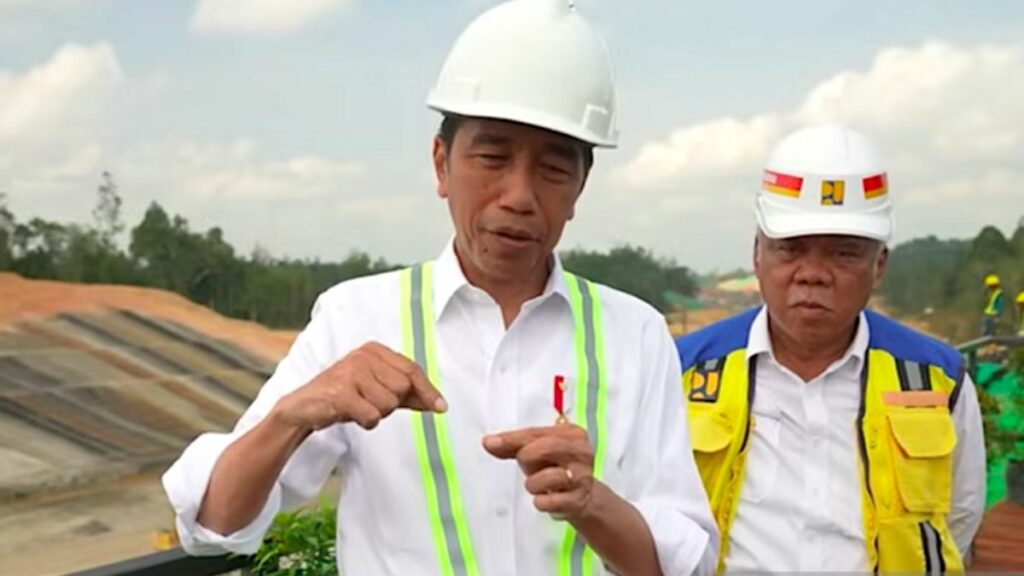
President Jokowi’s favorite look is a hardhat and a hi-vis vest.
His administration has built a massive number of roads and expressways. This goes a long way towards addressing spatial inequality, generates jobs, ties the country together (always a concern in time zone spanning, multi-ethnic Indonesia), and is popular. Unfortunately, as several people have already mentioned to me, a lot of it is of course in Java and points east.
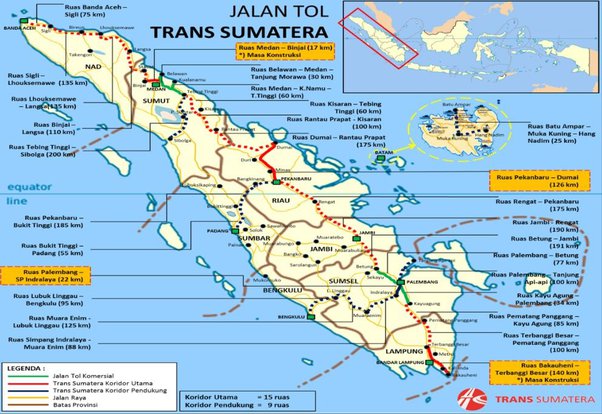
Most of the Trans Sumatra Expressway is still just a plan. Getting around is hard.
Cars
Toyota is the king of the road. Overwhelmingly. There are a few Hondas and Mitsubishis. I have yet to see a NIssan. Electrics are coming in with a few small ones from Chinese maker Wuling (started local production 2015). Government has opted for Ioniq 5s and they drive like maniacs. Very few Alphards or Land Cruisers–only for the quite wealthy. The venerable Kijang is the workhorse for businesses, hotels, hospitality, guide tours, and families. These have been around forever. I remember them 25 years ago as very boxy bare sheet metal no special interior to speak of kind of knock offs of old Land Cruisers or Land Rovers. Now, they have all the standard equipment. The other Toyota you see is the Avanza. Smaller and cheaper, so far almost every Gojek Car I have hired has been an Avanza or a Yaris. They are affordable and do the job.
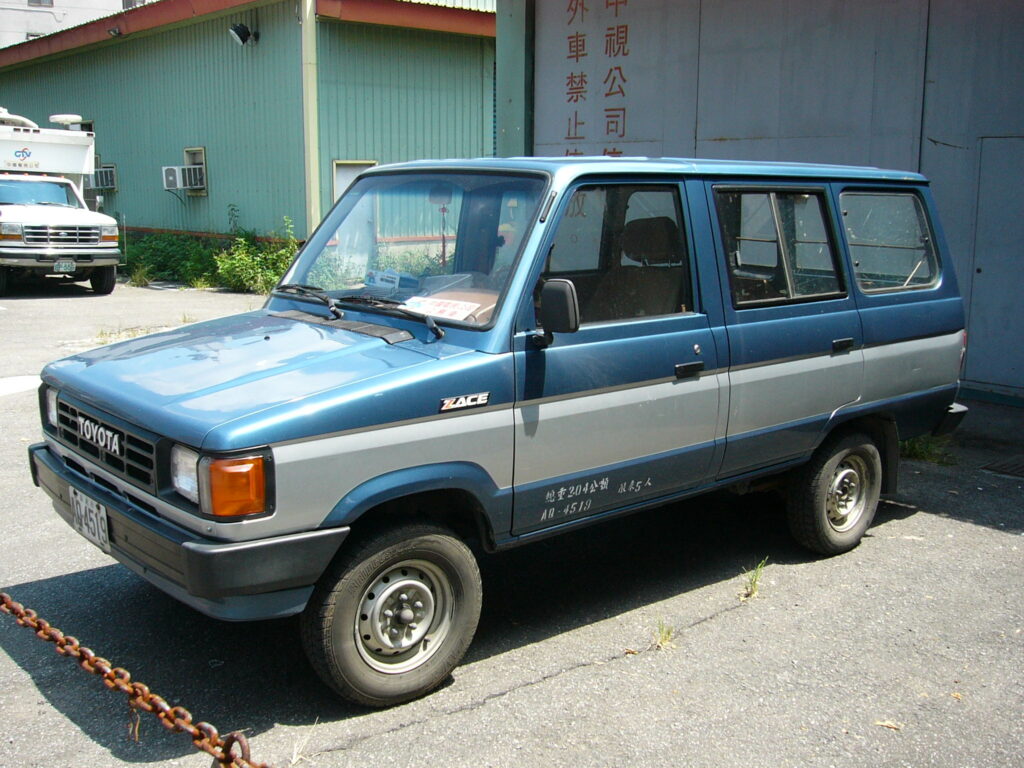
Model 3 KIjang built in the 80s and 90s.
You used to see a lot of imported used Japanese vehicles. Traffic is on the left here, so the right side driver models work. There was a big export market for ten-year-old cars from Japan. And, people used to keep them on the road here forever no matter how much they were smoking and puffing because fuel used to be highly subsidized and so cheap that if you could make a vehicle move at all, you’d gas it up. No more. All the cars I’ve seen have been late model and probably mostly domestically produced or from Thailand.
What you do not see anywhere are the typical very small kei-cars popular in Japan. I thought they would be popular. Easier to get through traffic, cheaper to buy, cheaper to run, and cheaper to maintain, they would seem to be a natural fit. And, without loads of big-ass pickup truck and SUVs on the road here, they are in less danger of being squashed. But, nope. No little Daihatsu Miras or Suzuki Altos.
Motor
Motor is Bahasa Indonesia for motorcycle or scooter. They are the way to get around as a driver or passenger. Most travel guides for areas outside cities suggest renting a motorcycle to get around. It really is the most practical way to see the country and to move as you like. However …
Once, I saw three motorcycle crashes during rush hour in Bali on a taxi ride from the airport to the hotel. At the end of the trip I was in a taxi that crashed a bike. Luckily, nobody was seriously injured in any of these. But, it has been 25 years since I rode a motorcycle. In touristed areas the other riders may have never ridden a bike before. And, in the city it would be just plain crazy. I do not know the local rules. I think I have figured out which red lights in Medan are optional and which riders are actually expected to run, but I do not want to try to figure that out on the fly. Not for me as a rider, or as a passenger.
Gojek
Which brings me to Gojek. This is a hugely successful “unicorn” business in Indonesia. Derived from the local term ojek for motorcycle taxis, it provides that and so much more. Motorcycle taxis, cars, package deliver, grocery shopping, restaurant delivery. Anything you want all in one app. In some locations they will deliver hairdressers or masseuses to your door. They even do housecleaning in between rush hours when demand for rides is low.
A ride in a Gojek car is great chance to chat with someone local in some mishmash of English, Bahasa Indonesia, or Japanese. I had a couple of Gojek drivers in Jogjya six years ago or so who had lived in Osaka for a while. They did their three-year “technical training” at a factory (which is really just a loophole for some really oppressive exploitation of foreign workers in Japan, but that is another story) and came back with enough money to buy a car and set up as drivers.
It’s always kind of a balancing act. The drivers usually want to practice their English and I want to practice my Indonesian. I don’t want to extract too much from them as free teachers –I do tip well for the rides. Sometimes they speak far better English than my Bahasa, but sometimes my Indonesian is better. It’s always fun. Yesterday I had two rides and both drivers wanted to take selfies with me after. I need to do more selfies with people I meet along the way.
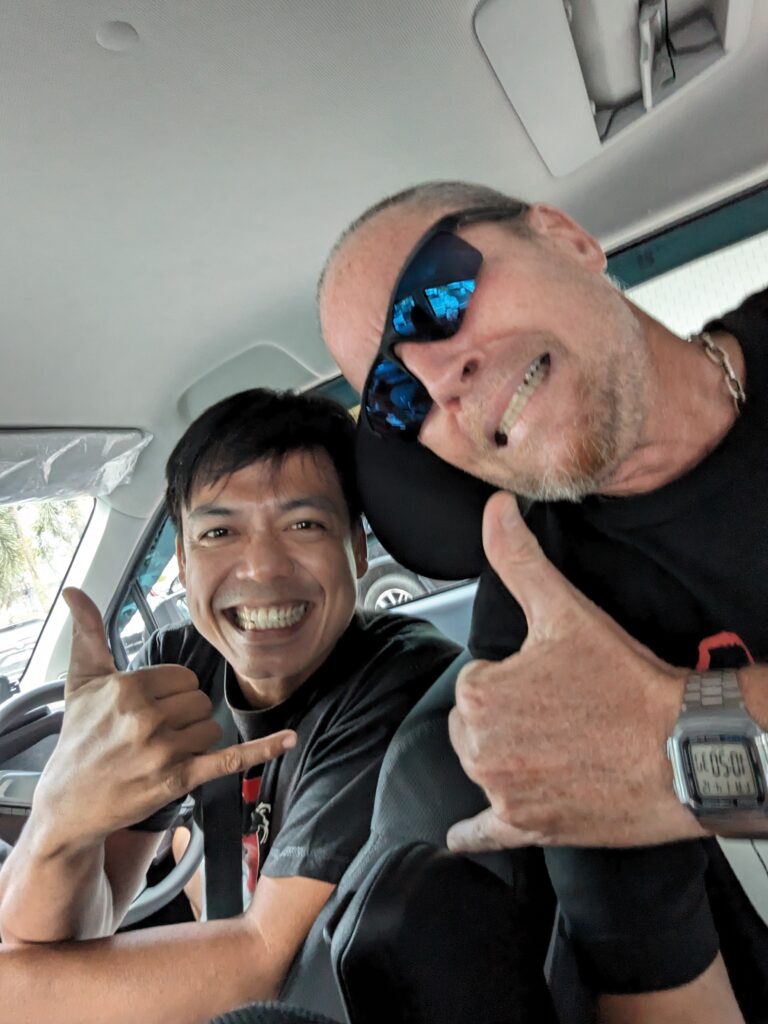
Pak Alfian took me from the hotel to the supermarket and ATM Center. Conversation went a little like this. Mostly in English.
A: How are you? I am so happy you are in my car Pak Teddy! Where are you from?
T: I am American.
A: Oh! America! Have you seen Metallica! (Head banging commences.) I hate this fucking radio! It sucks! As he pounds the dashboard that is pumping out some bland Indonesian pop pablum.
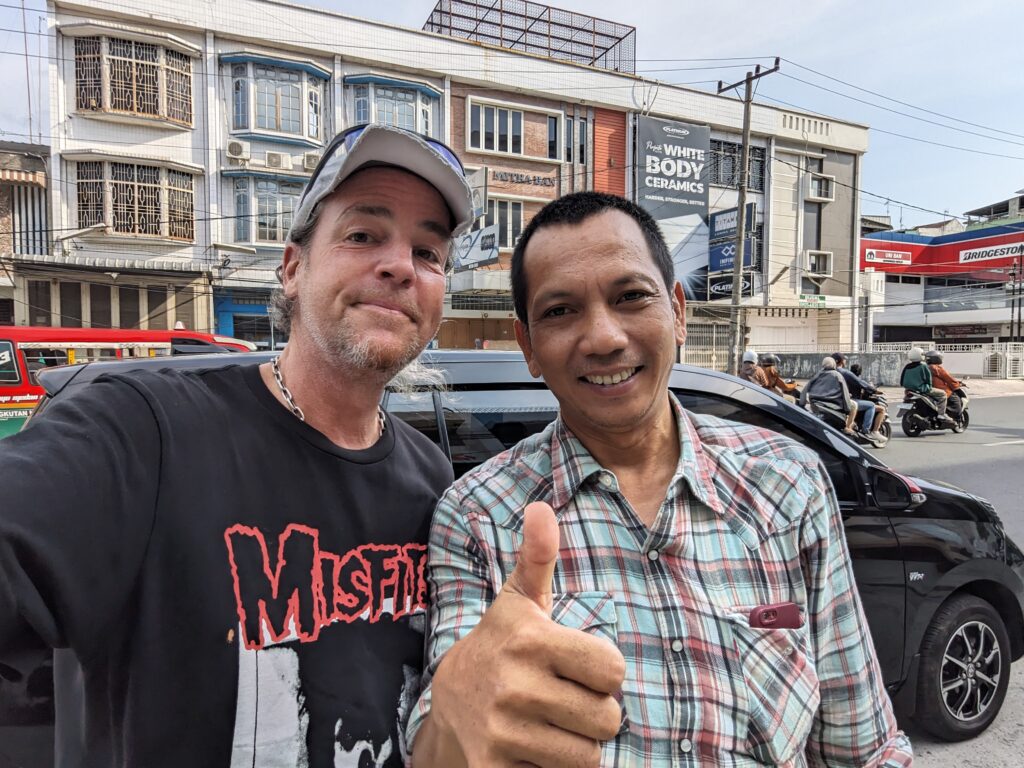
Pak Roni took me to the post office later. We conversed in a mix of Indonesian and English. I asked him how long he has been driving for Gojek. Just five months in his free time. He is administrative staff at a school or board of education office. He asked me about my work, and when I told him I was a professor, he was shocked. Can’t really blame the guy. I asked him what he thought my job was, “You look like a gambler,” he replied.
Asked where he is from, Roni explained that he is Batak. Later, I met a couple at restaurant and they also told me they are Bataks. There are so many ethnic groups in Indonesia. One of the things that makes it fascinating. I will be meeting many, many more Batak people as I go along.
Angkot / Bemo / Mikrolet
Depending where you are this is the name for local jitneys. They are small vans with a hard bench seat running along each side that run along a set route, usually up and down a main road or coastal road, or just go wherever. Rode a lot of these in Bali, Lombok, and Sulawesi. Sometimes there is a conductor standing on the running board calling for custom and collecting fares. They all have informal names. The private ones may have pretty wild paint jobs, neon, and serious sound systems. Angkots are the official public version. Still plenty of Angkot Kota running around Medan. I wonder if I’ll see more private ones further north or west?
I was surprised not to see any on Bintan or Batam. My reliable informant, Boyski, told me they used to run around the island, but Gojek has taken up a lot of that demand for “just get me a kilometer or three down the road.” Also, just looking around, the standard of living has improved for so many people. Seems like every family can afford a motorcycle of their own, or two or three.
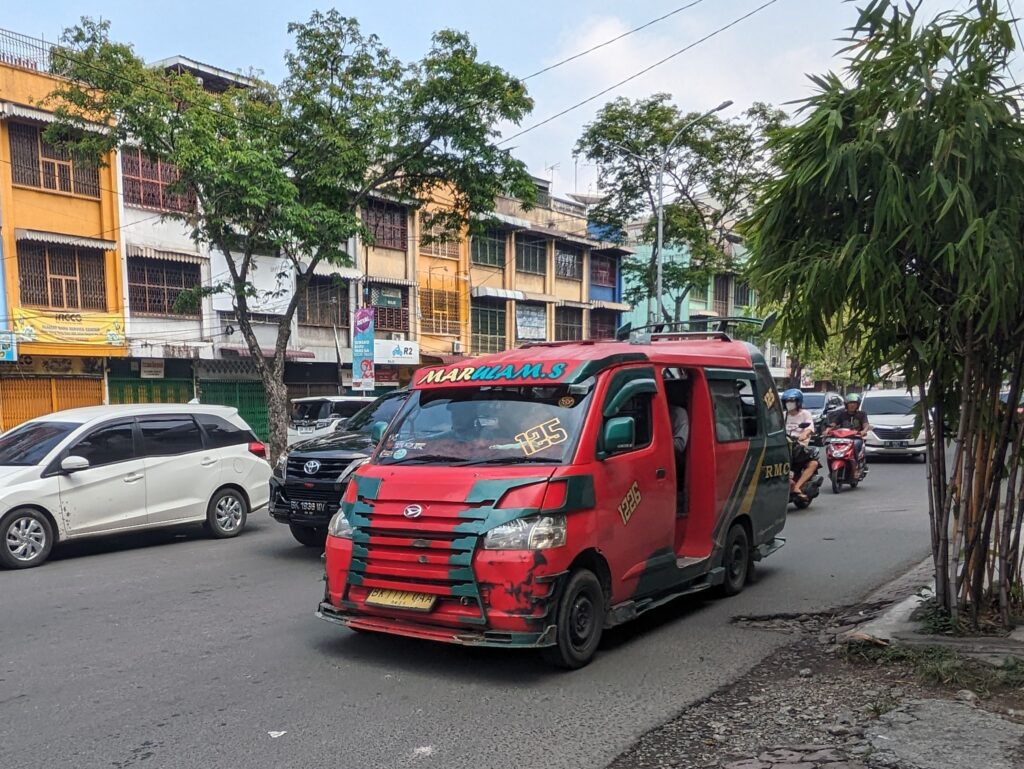
Typical Angkot Kota in Medan.
Tukang Parkir
Some blocks have parallel parking, but where it is busy or high demand and there is space, parking is pull in forward on a diagonal. Which means drivers have to back out into traffic with limited visibility. This, the Tukang Parkir– literally Parking Craftsman or Parking Master. Sometimes he wears a hiviz vest and may even have a badge, but usually he is just the guys strutting up and down the section of the block with a fist full of small bills gesturing imperiously and yelling directions. He’ll get you in and make sure you are lined up properly on the diagonal or even direct very basic parallel parking. You give him a tip and and he’ll keep an eye on your car. When it is time to go, he places his body in harms way and waves his arms to stop traffic so you can get out.
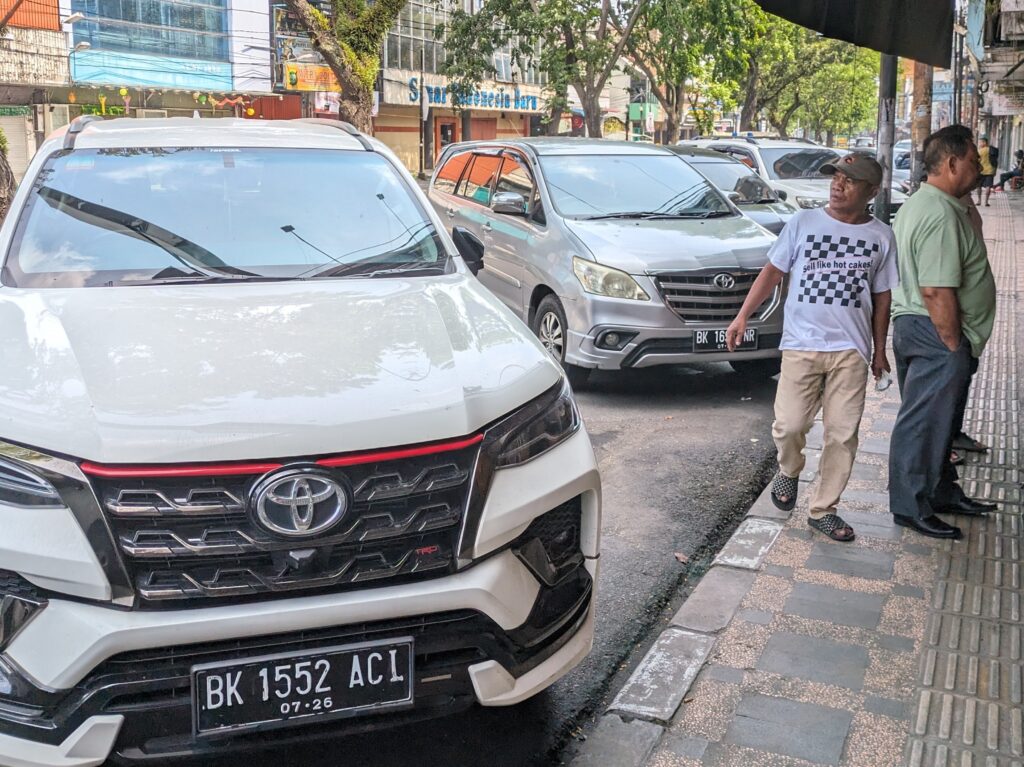
Typical Parking Craftsman at work. Note the stack of bills in his left hand.

Dad
Damon
T O'Neill
T O'Neill